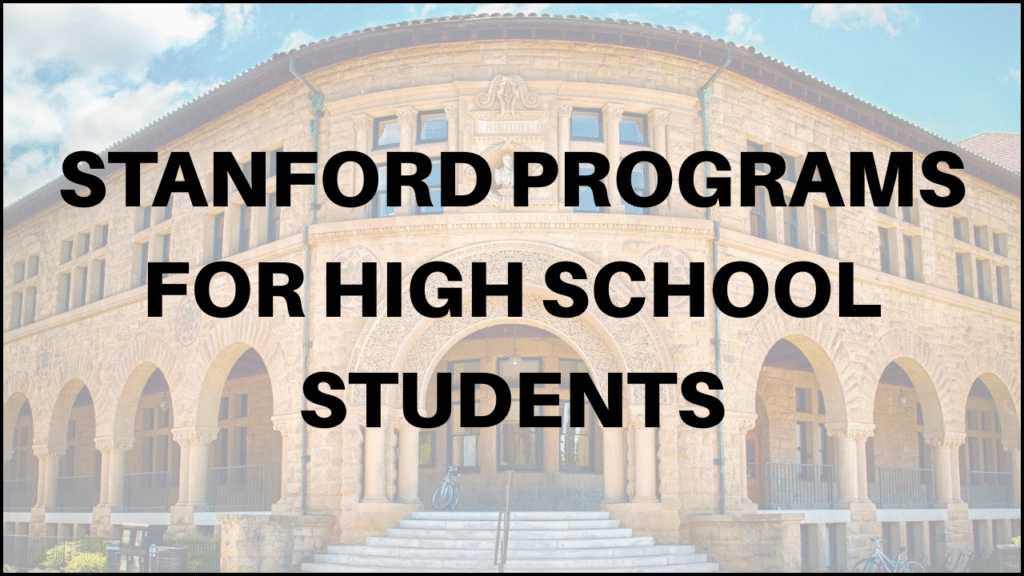
Stanford University offers a wide range of programs specially designed for ambitious high school students who want to explore academics beyond their classrooms. Opportunities at Stanford help young learners gain exposure to world-class research, university-style teaching, and skill development in both STEM and the humanities. A unique environment at Stanford allows high school students to challenge themselves intellectually, connect with peers from across the world, and prepare for future academic and career goals.
Table of Contents
Overview of Stanford Programs for High School Students
| Program | Focus Area | Format | Duration | Eligibility | Key Benefits |
|---|---|---|---|---|---|
| Stanford Pre-Collegiate Summer Institutes | Interdisciplinary subjects | Online / On-campus | 2-3 weeks | Grades 8–11 | Intensive study in chosen subjects |
| Stanford Summer Humanities Institute | Literature, philosophy, history | On-campus | 2-3 weeks | Grades 10–11 | Critical reading and discussion with professors |
| Stanford University Mathematics Camp (SUMaC) | Advanced mathematics | On-campus | 3 weeks | Grades 10–11 | Problem-solving and research in math |
| Stanford AI4ALL | Artificial Intelligence | On-campus | 3 weeks | Grades 9–11 | AI applications and ethics in technology |
| Stanford Summer Session | College-level courses in multiple disciplines | On-campus / Online | 8 weeks | Ages 16+ | Earn Stanford credits and live like an undergraduate |
| Stanford Online High School Summer Courses | Humanities, sciences, languages | Online | 5-8 weeks | Grades 7–12 | Flexible online learning with expert faculty |
| Stanford Pre-Collegiate University-Level Online Math & Physics | Math and physics | Online | Full academic year or semester | Grades 9–12 | University-level rigor with self-paced flexibility |
Stanford Pre-Collegiate Summer Institutes
- Focus: A wide range of subjects, including biosciences, creative writing, computer science, engineering, philosophy, and business.
- Format: Intensive short-term courses that mimic college-level seminar style.
- Experience: Students immerse themselves in project-based learning, discussions, and mentorship from Stanford instructors.
- Outcome: Exposure to advanced topics that encourage deeper intellectual curiosity.
Stanford Summer Humanities Institute
- Focus: Human thought, culture, and history. Topics may include classical philosophy, Shakespeare, political thought, and global history.
- Format: Reading seminars, small group discussions, and guided research.
- Experience: Students live on campus and engage in meaningful conversations about human experiences across centuries.
- Outcome: Strong analytical, critical reading, and argumentation skills that prepare students for higher studies in the humanities.
Stanford University Mathematics Camp (SUMaC)
- Focus: Pure and applied mathematics with deep dives into number theory, combinatorics, and algebra.
- Format: Rigorous coursework taught by Stanford faculty and graduate students.
- Experience: Students work on problem sets, collaborate in groups, and participate in research-style exploration.
- Outcome: Development of advanced problem-solving skills and exposure to the culture of mathematical research.
Stanford AI4ALL
- Focus: Artificial Intelligence and its ethical use in society.
- Format: Lectures, lab sessions, and mentorship by Stanford computer science faculty.
- Experience: Students gain hands-on practice in machine learning and AI applications. Guest speakers introduce real-world AI challenges and ethical debates.
- Outcome: Knowledge of how AI impacts industries, and preparation for careers in technology, ethics, and innovation.
Stanford Summer Session
- Focus: Academic courses in sciences, engineering, arts, and social sciences.
- Format: Students live on Stanford’s campus, attend lectures, and complete assignments just like undergraduates.
- Experience: Over 200 courses are available, and students can earn official Stanford University credits.
- Outcome: Real university experience, time management skills, and a strong addition to academic transcripts.
Stanford Online High School Summer Courses
- Focus: Flexible online learning across humanities, STEM, and foreign languages.
- Format: Virtual classrooms with live sessions and independent projects.
- Experience: Students interact with peers worldwide while maintaining flexible schedules.
- Outcome: Opportunities to deepen academic understanding while balancing personal commitments.
Stanford Pre-Collegiate University-Level Online Math & Physics
- Focus: High-level topics such as multivariable calculus, linear algebra, quantum mechanics, and relativity.
- Format: Online, semester or year-long courses.
- Experience: Students learn through problem-solving, online lectures, and assignments.
- Outcome: Preparation for advanced college coursework in mathematics and physics.
Key Benefits of Stanford Programs for High School Students
- Exposure to Academic Rigor
Students experience courses that go far beyond the traditional high school curriculum. - Access to World-Class Faculty
Direct learning from Stanford professors and researchers builds academic confidence. - Global Peer Network
Opportunities to meet and collaborate with high-achieving peers from different countries. - Skill Development
- Critical thinking
- Problem-solving
- Academic writing
- Research skills
- College Readiness
Early exposure to university life prepares students for the transition to higher education.
Comparison of On-Campus vs. Online Stanford Programs
| Aspect | On-Campus Programs | Online Programs |
|---|---|---|
| Learning Environment | Immersive campus experience | Flexible, accessible globally |
| Interaction | Face-to-face with peers and faculty | Virtual classrooms and forums |
| Duration | 2–8 weeks (intensive) | 5 weeks to a full academic year |
| Subjects | Broader range, including labs and research | Focus on math, physics, and humanities |
| Additional Benefits | Exposure to the college lifestyle | Balance of academics with personal schedule |
Application Process and Requirements
- Eligibility: Varies by program, typically open to students in grades 8–12.
- Application Components:
- Online application form
- Academic transcripts
- Teacher recommendations
- Personal essays highlighting academic interests and motivation
- Selection Criteria: Demonstrated academic excellence, intellectual curiosity, and commitment to learning.
Fees and Financial Aid
- Program Costs: Range from a few thousand dollars for short-term institutes to higher fees for full summer sessions.
- Financial Aid: Stanford provides need-based financial assistance for qualified students to ensure accessibility.
- Scholarship Opportunities: Limited scholarships available for students with outstanding merit or financial need.
Other Important Information
- Residential Life: On-campus students experience dorm life, recreational activities, and supervised independence.
- Extracurricular Opportunities: Workshops, guest lectures, cultural events, and networking sessions.
- Long-Term Benefits: Students often report increased confidence, clarity in career goals, and strong additions to college applications.
The Way Forward
Stanford programs for high school students create unique pathways for young learners to challenge themselves academically, discover new passions, and connect with world-class scholars. A combination of rigorous academics, diverse subjects, and cultural exposure makes these programs an exceptional opportunity for motivated students. Early engagement with such enriching experiences often shapes future academic choices and career directions, making Stanford’s offerings highly valuable for students aiming to grow beyond traditional schooling.





